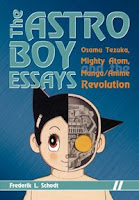 Author: Frederik L. Schodt
Author: Frederik L. Schodt
Publisher: Stone Bridge Press
ISBN: 9781933330549
Released: July 2007
The Astro Boy Essays: Osamu Tezuka, Mighty Atom, and the Manga/Anime Revolution written by Frederik L. Schodt is one of the few full-length publications available in English devoted to the life and work of Osamu Tezuka. Published by Stone Bridge Press in 2007, it is also one of the first. Although there now exist several more resources, the only other book about Tezuka that I’ve had the opportunity to read was Helen McCarthy’s The Art of Osamu Tezuka. Because Tezuka was such an influential creator, it’s somewhat surprising that there hasn’t been more written. (Granted, I’m hard pressed to name many other mangaka who have had entire books devoted solely to them.) Schodt is in a unique position to write about Tezuka and Astro Boy. He was a friend of Tezuka’s who not only personally knew the creator, but who also worked with him. Schodt was also the translator for Dark Horse’s English-language release of the Astro Boy manga, so he is quite familiar with the material.
Osamu Tezuka was an instrumental pioneer in the realms of manga and Japanese animation. One of his most iconic and well-loved creations wast Tetsuwan Atomu (Mighty Atom), better known in the United States as Astro Boy. Around the world there are many fans who, although they may not recognize Tezuka’s name, know and adore Astro Boy, the cute boy robot who fought for peace. Astro Boy was first introduced as a character in the story “Ambassador Atom” in 1951 before becoming the star in his own manga series in 1952. Tezuka would continue to work on and revisit the Astro Boy manga well into the eighties. In 1963, Astro Boy become Japan’s first animated weekly television series and was subsequently exported to the United States. Tezuka would later create a color version of this black and white series in 1980. In addition to successful manga and anime series, Astro Boy also had a strong merchandising line.
The Astro Boy Essays consists of an introduction, eight chapters or essays, an afterword, notes, bibliography, and index. Two appendices are also included which list the Japanese and English titles of the Astro Boy manga stories and the 1963 anime episodes as well as the order of their release. Scattered throughout the book are a few informational sidebars (including a fascinating comparison of the replies that Tezuka and Yukio Mishima gave in response to a literary magazine’s survey), plenty of black-and-white illustrations and photographs, and sixteen pages of full-color artwork. Each of the essays are written in such a way that they can be read separately, but read together they provide a comprehensive look at Astro Boy and its importance as a work. Schodt covers many different aspects of Astro Boy: it’s place as a national icon, it’s creation and evolution, it’s influence on Japanese and American markets, its impact on the field of robotics, it’s many messages, Tezuka’s complicated relationship with the work, and so on.
The Astro Boy Essays is an excellent work and a valuable resource. Schodt has done his research and it shows, but the book has been written with a more casual, general audience in mind rather than a strictly academic one. I like Schodt’s approach of focusing on a specific creation, in this case Astro Boy in all of its incarnations, as a way to explore Tezuka’s innovations and influence. By tracing the evolution of Astro Boy, Schodt is also able to trace the evolution of Tezuka’s work in general while still limiting the scope of the book’s subject to something manageable. The Astro Boy Essays may be a slim volume, but it’s an accessible, engaging, enlightening, and highly informative one. Schodt covers a wide range of fascinating material quickly and effectively. The Astro Boy Essays are a fantastic introduction to Astro Boy, Osamu Tezuka, and their lasting influence on manga and anime.

